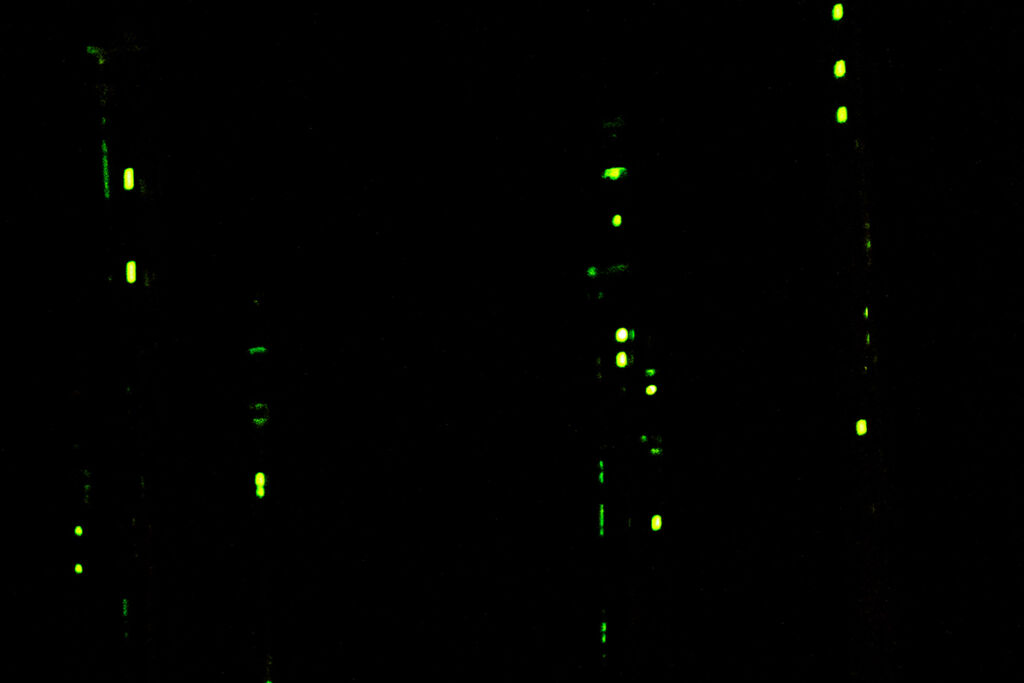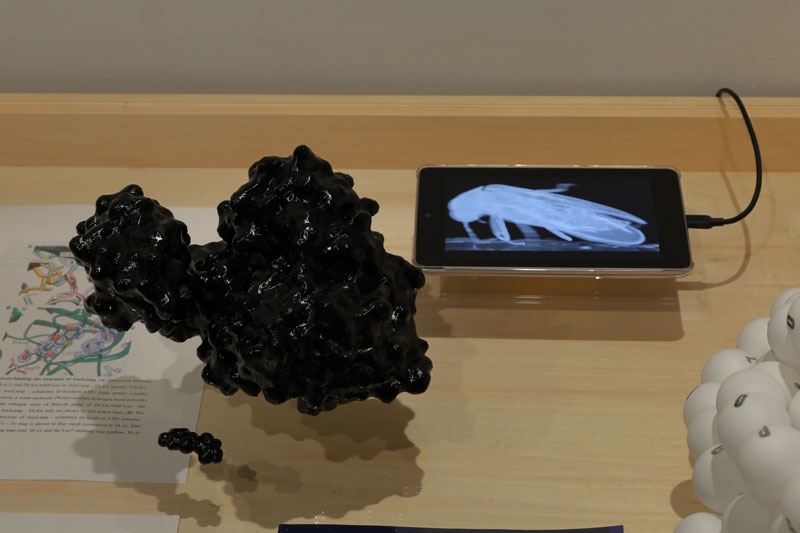Text by Daniela Silva

Nelo Akamatsu is an artist whose explorative and interdisciplinary nature has allowed him to master art and science. He pushes the boundaries of artistic exploration by integrating science, biotechnology, and artistic practice into his installations. Akamatsu’s latest exhibition, Perhaps, Art Begins with the Fireflies, is a monumental creation awarded an Honorary Mention in the AI & Life Art category of Prix Ars Electronica 2023.
The driving forces behind Perhaps, Art Begins with the Fireflies were based on a collaboration between Akamatsu and Professor Yuichi Oba, an applied biologist and bioluminescence specialist. They successfully reproduced the luminescence of ancient fireflies through genetic engineering, opening a window to a 100 million-year-old natural phenomenon. The collaboration was guided by a mutual interest in connecting art and science.
Akamatsu recounts This work is the sublimation into art, of the academic research by Professor Oba… I was attracted by the strong affinity with art in the research content. I immediately offered Professor Oba to collaborate with him on a new installation work using the luminescence of ancient fireflies.
The choice of fireflies was not arbitrary; it symbolised the primordial art form. Akamatsu explains that Deleuze & Guattari’s assertion inspired the title; Perhaps, art begins with the animal. He goes on to say, I likened this figure to the countless fireflies that must have flown around with a faint green glow for courtship behaviour as far back as 100 million years ago… In addition, I wanted to create a work that brought science art… more into the context of art.
The installation is more than a visual spectacle; it delves into profound philosophical concepts. Akamatsu explains the representation of “Umwelt” and references Darwin and Uexküll. I considered that the surplus of the sexual instincts of animals, born out of the chaos of the universe, became the origin of art, he explains. The work juxtaposes the universe’s fundamental forces with the intrinsic aesthetic behaviours of life, resulting in a piece that transcends traditional artistic dimensions.
The collaboration with Professor Oba was not without its challenges, but the synergy between art and science fostered a creative environment. Akamatsu reflects on this unique partnership. In my previous works, I have taken various phenomena from my scientific interest and sublimated them into artworks… I have made a new attempt to incorporate and integrate many elements into the installation… Such expression was made possible with the cooperation of Professor Oba.
Their collaboration extended the boundaries of Akamatsu’s work, incorporating the reproduction of the fireflies’ luminescence and various archival materials related to fireflies and poetic narratives.
The installation is meant to engage the audience in an experiential way. Akamatsu’s wish for those who view the work is profound, hoping to awaken a sense of awareness and connection with the world.
He states that the world is full of vibrations; as you immerse yourself in the delicate vibrations of glows and the movement of your work, you will notice that the flow of time is not uniform. I hope you will imagine what passes through the chaos of various vibrations of reality as our work carves out ‘time and rhythm’ within it.
Nelo Akamatsu’s Perhaps, art begins with the fireflies, is not just an artistic endeavour but a multidimensional exploration that bridges art, science, philosophy, and experience. It is a testament to Akamatsu’s fearless innovation and a symbol of the limitless possibilities when art can wander into new and unexplored territories.
Reflecting on his artistic journey, especially in the last five years, Akamatsu acknowledges the impact of the pandemic on his work. He notes, since the pandemic, like many other artists, I have had fewer opportunities to exhibit my works abroad… in creating new works, I have not confined myself to my internal world… but I have rather been more oriented toward collaborations with other artists and scientists. These collaborations have led to enriching encounters, stimulating Akamatsu’s inspiration and resulting in the development of his award-winning installation.

The journey from concept to realization was fraught with challenges and opportunities, as Akamatsu worked hand in hand with Professor Oba to produce something unique and meaningful. He remarks on the collaborative process: In the actual production, we often felt the unpredictable difficulty of utilizing scientific materials in an art installation, but it was also a great challenge with rewarding for both of us to solve each problem one by one.
This collaboration with a scientist was not just a departure for Akamatsu but a realization of a more profound connection between different disciplines. It symbolizes an openness to new methodologies and approaches, allowing the birth of a piece that transcends mere aesthetics.
Perhaps, art begins with the fireflies also represents an exploration into the origins of art itself, as seen through the lens of the natural world. Akamatsu opens up a conversation about what art truly means and where it finds its roots by tying together the glow of fireflies, ancient biology, scientific research, and philosophical underpinnings.
The combination of art and science in Akamatsu’s work brings about a refreshing perspective on the potential of collaborative practice. It demonstrates that the boundaries between disciplines can be porous and that an artist can bridge gaps to create something wholly original and thought-provoking.
Nelo Akamatsu’s innovative installation invites us to reflect, explore, and connect with the primal artistic instincts that dwell within nature and ourselves. It challenges conventional boundaries and opens new horizons, demonstrating that the intersection of art and science can yield unexpected and mesmerizing results. It’s a beacon of inspiration for artists, scientists, and viewers alike, illuminating the path toward a more integrated and enriched understanding of the world.
The installation is currently showing in the group exhibition at Mizuma Art Gallery in Tokyo. More info here.





